Trends in Engineering Enrolment and Degrees Awarded 2014-2018
Message from the Chief Executive Officer

Engineers Canada is pleased to publish the 2019 edition of Canadian Engineers for Tomorrow, highlighting trends related to enrolment and degrees awarded in post-secondary engineering education in Canada. This document comprises information on all academic terms from the calendar years 2014 through 2018.
Canadian post-secondary institutions continue to report a strong growth in undergraduate degrees awarded, presenting 18.9 per cent more engineering degrees in 2018 than in 2014. It is heartening to see that most engineering disciplines awarded more degrees in 2018 than in 2014, and that most engineering disciplines have experienced a growth in undergraduate enrolment numbers in the same period.
We are excited to report that the proportion of female students enrolled in undergraduate and postgraduate programs, as well as the proportion receiving undergraduate degrees, has reached an all-time high. As of 2018, females comprised 22.0 per cent of undergraduate students, 26.3 per cent of postgraduate students, and 21.1 per cent of undergraduate engineering degrees awarded. As the profession moves toward achieving our 30 by 30 goal, where 30 per cent of newly licensed engineers are women by 2030, this increasing representation at the undergraduate level is an important indicator of progress.
Meanwhile, Canadian engineering programs remain a popular choice for international students. In 2018, the number of international undergraduate students reached 13,941, or 15.6 per cent of total undergraduate engineering enrolment.
For the fourth consecutive year, Engineers Canada collected data regarding Indigenous students’ enrolment and degrees awarded. Indigenous peoples are still greatly underrepresented in engineering education, accounting for only 0.5 per cent of reported undergraduate students. This is around ten times lower than the 4.9 per cent of people in Canada who identify as Indigenous (Statistics Canada, 2017).
Engineers Canada will continue to track this information in the coming years to identify trends and to further encourage enrolment and achievement by post-secondary engineering programs that reflect Canada’s diversity.
Gerard McDonald, MBA, P.Eng.
Chief Executive Officer
Acknowledgements
In preparing this report, Engineers Canada gratefully acknowledges the contribution of data and information from the deans and associate deans of the engineering and applied science faculties at Canadian higher education institutions.
Report By: Matthew Domsy & Adam Rodrigues
Introduction
Canadian Engineers for Tomorrow is an annual examination of Canada's undergraduate and postgraduate engineering programs. It evaluates trends in part- and full-time student enrolment and degrees awarded over a five-year period. In 2018, 45 higher education institutions provided information on their enrolment, programs, and degrees awarded.
The results highlight enrolment trends by discipline and institution, as well as the number of undergraduate and postgraduate degrees awarded each year. These results reveal trends specific to discipline, education, and sex, as well as the number of engineering graduates available to enter the labour market and international students’ participation in Canadian engineering education. Enrolment trends at the undergraduate, master’s, and doctoral levels are compared, along with male and female students studying and graduating from engineering programs. For the fourth consecutive year, data regarding Indigenous peoples’ enrolment and graduation from engineering programs is presented in this report. Engineers Canada plans to continue collecting this data in coming years to be able to identify emerging trends.
Data is provided by higher education institutions to Engineers Canada. Engineers Canada compiles the information in this report. Findings are then shared with Engineers Canada’s stakeholders and with the public. Engineers Canada greatly appreciates the contribution of these higher education institutions.
NOTE: When comparing data between years, only those higher education institutions who consistently responded to the survey year-after-year are included in the comparison. If an institution did not provide data in one or more of those years, they were not included in the comparison. This was done to ensure that the comparisons are fair and are as accurate as possible.
Undergraduate students
Total undergraduate student enrolment
Undergraduate student enrolment in accredited engineering programs totalled 89,242 in 2018. This is an increase of 16.0 per cent from 2014 and an 8.0 per cent increase from 2017.
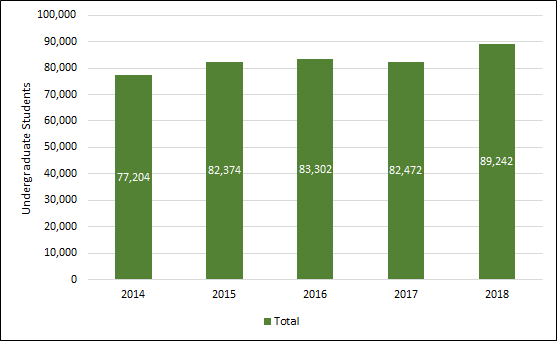
Total undergraduate student enrolment by discipline
The undergraduate engineering disciplines with the highest enrolment in 2018 were mechanical engineering, civil engineering and electrical engineering, representing 22.7 per cent, 14.5 per cent, and 13.6 per cent of total undergraduate enrolment, respectively. Conversely, the fields that accounted for the smallest proportion of undergraduate enrolment were geological engineering (0.7 per cent), materials or metallurgical engineering (1.0 per cent), and mining or mineral engineering (1.2 per cent).
Biosystems engineering (27.5 per cent), software engineering (27.4 per cent), and industrial or manufacturing engineering (20.4 per cent), demonstrated the highest growth since the previous year. Similarly, the disciplines that experienced the largest cumulative growth from 2014 were software engineering (76.8 per cent), biosystems engineering (68.7 per cent), and computer engineering (57.2 per cent). Conversely, engineering physics (-27.7 per cent), environmental engineering (-25.2 per cent), and geological engineering (-7.0 per cent) had the largest decline from the previous year. Additionally, only four disciplines presented a decline in enrolment since 2014: engineering physics (-27.2 per cent), mining and mineral engineering (-22.7 per cent), geological engineering (-20.0 per cent) and environmental engineering (-13.6 per cent). Once again, these comparisons were made between institutions that consecutively replied to the enrolment and degrees awarded survey since 2014.

(2014-2018, full-time equivalent)
Total undergraduate student enrolment by province
The highest proportion of undergraduate enrolment continues to be located in the provinces of Ontario and Quebec. In 2018, these provinces accounted for 41.9 per cent and 30.3 per cent of total enrolment, respectively. Furthermore, Quebec and Alberta underwent the largest percentage increase in enrolment from the previous year, with growth of 28.3 per cent in Quebec and 6.7 per cent in Alberta.
The highest cumulative enrolment growth from 2014 occurred in Alberta (31.5 per cent) and Quebec (35.4 per cent).
British Columbia (-7.5 per cent), Saskatchewan (-5.1 per cent), and New Brunswick (-2.9 per cent) were the only provinces to experience a decrease from the previous year. New Brunswick (-11.3 per cent) and British Columbia (-4.6 per cent) were the only provinces to experience a decrease in enrolment since 2014.
Once again, these comparisons were made between institutions that consecutively replied to the enrolment and degrees awarded survey since 2014.
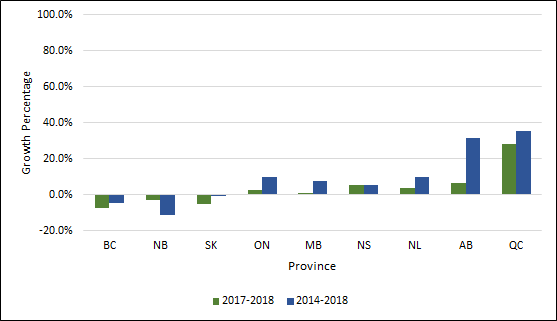
(2014-2018, 2017-2018, full-time equivalent)
Total undergraduate degrees awarded
The number of undergraduate degrees awarded totalled 16,497 in 2018, which is an increase of 4.5 per cent from the previous year when compared to the average annual increase of 4.4 per cent for the period of 2014 to 2018. Cumulatively, the number of degrees awarded across Canada has increased 18.9 per cent from 2014. Once again, these comparisons were made between institutions that consecutively replied to the enrolment and degrees awarded survey since 2014.
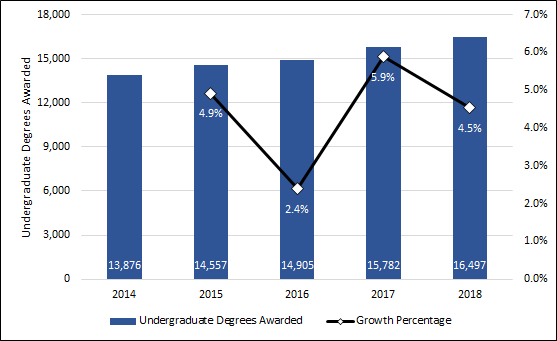
Chart 1.5 shows that Nova Scotia, Newfoundland, and Saskatchewan had the highest increases in undergraduate degrees awarded from 2017, with growths of 14.4 per cent, 11.0 per cent, and 7.4 per cent, respectively. Similarly, Manitoba, Saskatchewan, and Ontario experienced the highest increases in undergraduate degrees awarded from 2014, with growth of 31.5 per cent, 27.2 per cent, and 24.7 per cent, respectively.
Manitoba (-7.7 per cent), British Columbia (-6.2 per cent) and New Brunswick (- 3.5 per cent) experienced decreases in undergraduate degrees awarded from the previous year, while only Newfoundland (-41.8 per cent) experienced a cumulative decrease in undergraduate degrees awarded from 2014. Once again, these comparisons were made between institutions that consecutively replied to the enrolment and degrees awarded survey since 2014.

Mechanical engineering, civil engineering, and electrical engineering awarded the greatest number of degrees in 2018, representing 25.3 per cent, 16.8 per cent, and 13.4 per cent of the total, respectively. Furthermore, computer engineering exhibited the largest growth in degrees awarded from both 2017 (55.0 per cent) and 2014 (107.2 per cent).
Environmental engineering (-15.8 per cent), and engineering physics (-15.6 per cent) were the only disciplines to display decreases since 2014 in the number of undergraduate degrees awarded. Engineering physics (-27.3 per cent), biosystems engineering (-9.4 per cent), civil engineering (-2.7 per cent), and materials or metallurgical engineering (-2.2 per cent) saw a decrease since 2017.
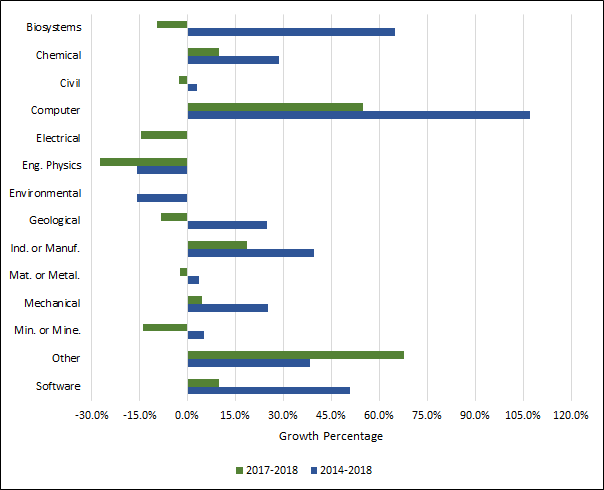
Postgraduate students
Total graduate student enrolment
Postgraduate student enrolment totalled 25,835 in 2018. When comparing institutions that consecutively replied to this survey since 2014, graduate student enrolment increased by 7.7 per cent from 2017 and 25.4 per cent from 2014, averaging a 5.9 per cent annual growth rate.
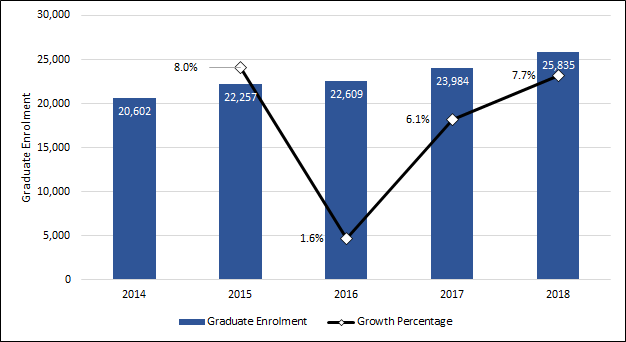
The province that experienced the highest growth in postgraduate enrolment over the previous year was New Brunswick (29.9 per cent), while Saskatchewan displayed the highest cumulative growth since 2014 (71.9 per cent). The greatest decrease from both 2017 and since 2014 was observed in Manitoba at -22.9 per cent and -30.1 per cent, respectively. Once again, these comparisons were made between institutions that consistently reported to the enrolment and degrees awarded survey since 2014.
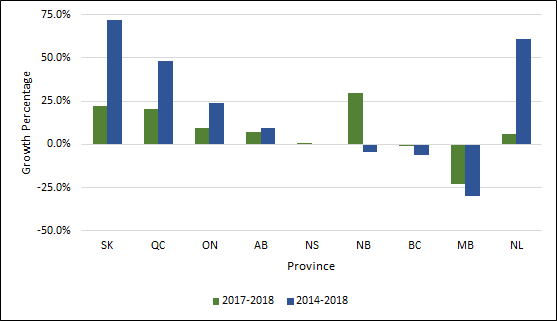
Total postgraduate degrees awarded
A total of 7,764 master's and 1,575 doctoral of engineering degrees were awarded in 2018, for a combined sum of 9,339 postgraduate degrees. This corresponds to a growth of 18.4 per cent in master’s degrees awarded and 0.7 per cent in doctoral degrees awarded from 2017. Similarly, a cumulative growth of 29.2 per cent in master’s degrees awarded and 17.0 per cent in doctoral degrees awarded was seen from 2014.
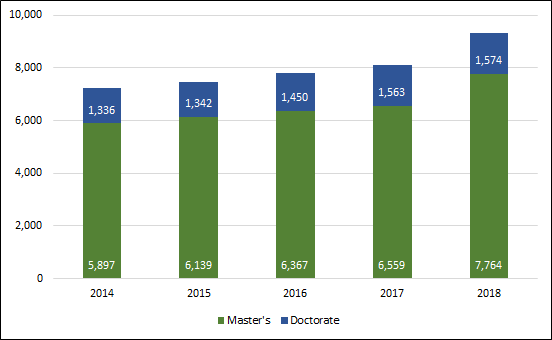
British Columbia had the largest growth in the number of postgraduate degrees awarded in both 2017 (33.7 per cent) and since 2014 (59.0 per cent).
Chart 1.10 indicates the average growth in master’s degrees awarded by province for the periods of 2014 to 2018 and 2017 to 2018, while chart 1.11 indicates the same trends for doctoral degrees. Once again, these comparisons were made between institutions that consecutively replied to the enrolment and degrees awarded survey since 2014.
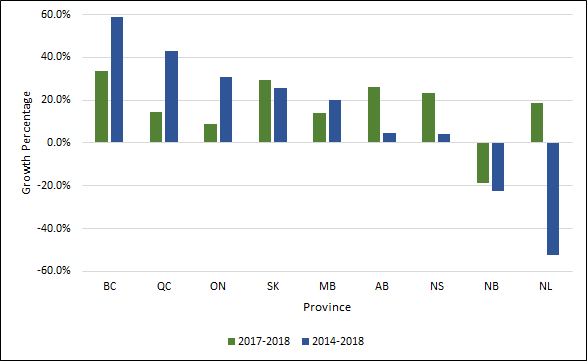

Female students
Female undergraduate enrolment
Female undergraduate enrolment remained above 20 per cent in 2018, with a 0.2 per cent increase from 21.8 per cent in 2017 to 22.0 per cent in 2018. The total number of females enrolled in undergraduate-level engineering programs has increased by 14.5 per cent since 2017 and 44.2 per cent since 2014.
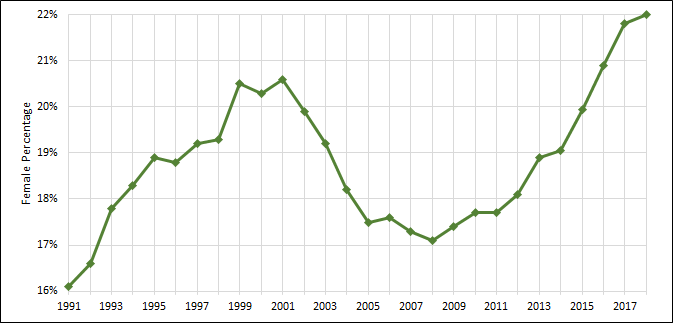
Female undergraduate enrolment by discipline
The disciplines that experienced the highest proportion of female undergraduate enrolment in 2018 were biosystems engineering (51.3 per cent), environmental engineering (43.7 per cent), and chemical engineering (39.8 per cent).
The disciplines with the lowest percentages of female undergraduate enrolment were software engineering (14.3 per cent), mechanical engineering (14.6 per cent), and mining and mineral engineering (14.6 per cent). While these three disciplines account for 31.6 per cent of the total number of undergraduate students, they only account for 21.0 per cent of the total number of female undergraduate students.
Furthermore, the disciplines that presented the highest growth in the proportion of female students from 2017 were biosystems engineering, software engineering, and mechanical engineering, which rose 37.6 per cent, 25.1 per cent and 14.6 per cent in 2018, respectively.
Similarly, the disciplines that experienced the highest growth in the proportion of female students from 2014 were software engineering, computer engineering and biosystems engineering, which rose 122.3 per cent, 111.7 per cent and 101.1 per cent in 2018, respectively.

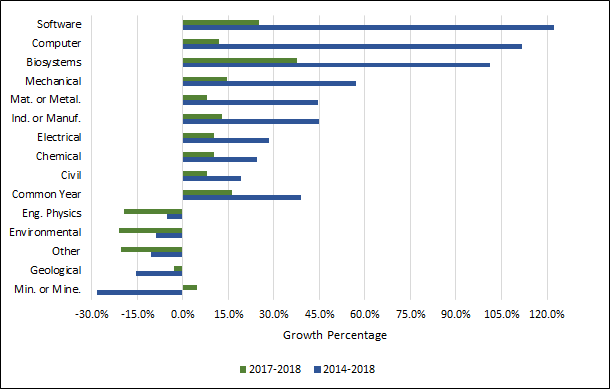
Female undergraduate enrolment by province
Newfoundland and Labrador had the highest percentage of female undergraduate students (27.0 per cent), while Saskatchewan had the lowest (18.0 per cent). Seven provinces experienced increases in female undergraduate enrolment since 2017, while eight provinces experienced increases since 2014. Once again, these comparisons were made between institutions that consecutively replied to the enrolment and degrees awarded survey since 2014.
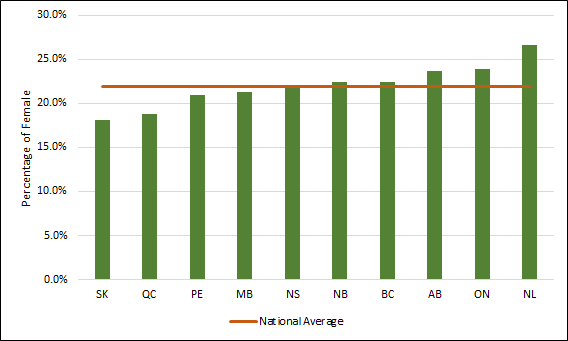
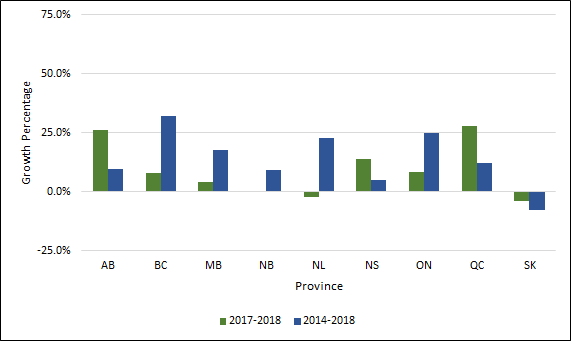
Undergraduate degrees awarded to female students
Of the 16,497 engineering degrees awarded in 2018, 3,486 were awarded to women, accounting for 21.1 per cent of the graduates. When comparing engineering programs that consecutively replied to this survey, increases of 13.5 per cent from 2017 and 42.9 per cent from 2014 were observed.

The province with the highest proportion of undergraduate degrees awarded to female students was Newfoundland and Labrador (29.6 per cent), followed by Alberta (22.9 per cent), and Nova Scotia (22.2 per cent). Additionally, Nova Scotia had the greatest increase in the proportion of undergraduate degrees awarded to female graduates when compared to 2017, with a growth of 102.4 percentage points overall.
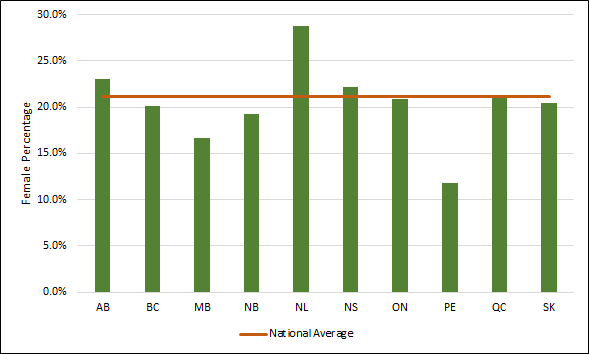
The disciplines that had the highest growth over the previous year in the proportion of undergraduate degrees awarded to female graduates were that of mining and mineral engineering (4.1 percentage points increase) and computer engineering (2.9 percentage points increase). The categories that experienced the highest growth from 2014 were those of environmental engineering (5.7 percentage points increase) and industrial or manufacturing engineering (4.5 percentage point increase). The growth in Prince Edward Island is ascribed to the fact that there is one university offering a full engineering program in the province. It opened in 2013 and has grown each year.
If it is assumed that the proportion of female students granted degrees matches pace with the number of female students enrolled, the proportion of undergraduate degrees awarded to female graduates will likely experience growth in the coming years due to the increase in the proportion of female undergraduate enrolment in many disciplines, as illustrated in Chart 2.3. This is especially prominent in the disciplines of environmental engineering, industrial or manufacturing engineering, and chemical engineering.
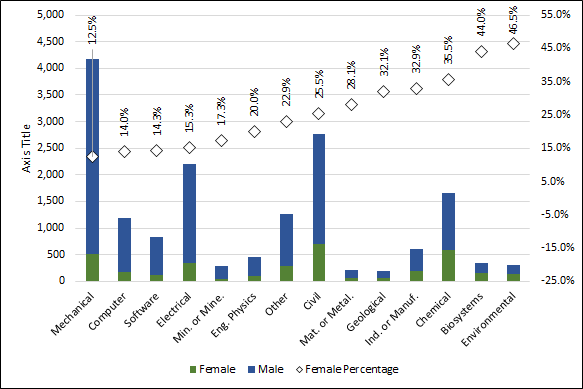
Female graduate student enrolment
The proportion of female students enrolled in postgraduate engineering programs continues to grow, reaching 26.3 per cent in 2018. When comparing institutions that consistently replied to this survey since 2014, an increase in proportion of 0.8 percentage points from 2017 and 2.2 percentage points from 2014 was observed.
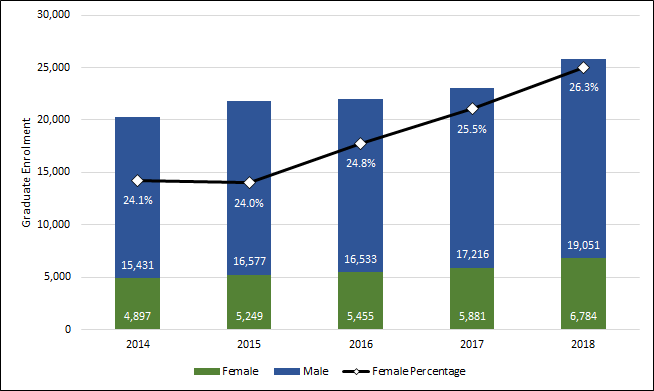
The highest proportions of female postgraduate enrolment in 2018 were in Prince Edward Island, British Columbia, and Alberta, with values of 33.3 per cent, 29.6 per cent, and 29.1 per cent, respectively.
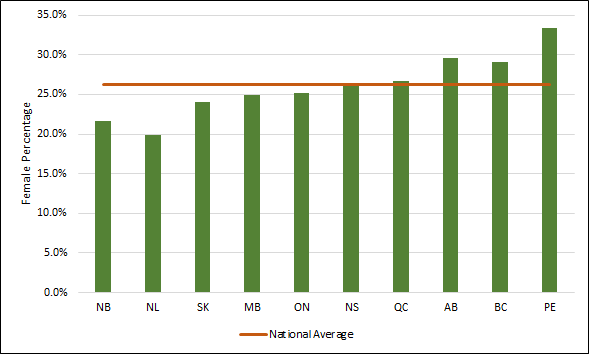
Postgraduate degrees awarded to female students
The number of postgraduate degrees awarded to female students in 2018 consisted of 1,960 master’s degrees and 393 doctoral degrees. When compared to 2017, this represented a 27.8 per cent increase in the number of master's degrees awarded and a 60.4 per cent increase for doctoral degrees awarded. However, when comparing institutions that consistently replied to this survey since 2014, the proportion of master's degrees awarded to female students has increased from 23.4 per cent in 2017 to 25.2 per cent in 2018, the proportion of doctoral degrees awarded to female students went from 15.7 per cent in 2017 to 24.9 per cent in 2018.

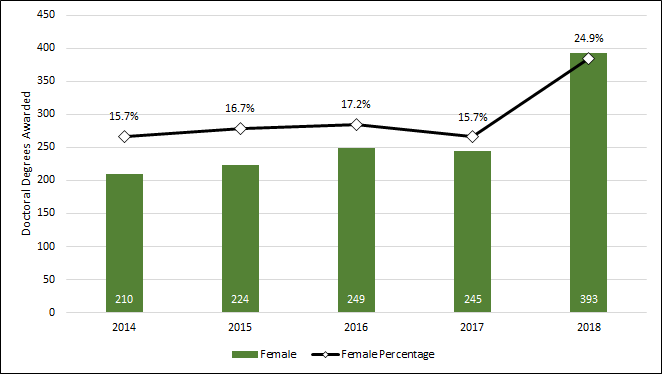
In 2018, the province with the largest proportion of master’s degrees awarded to female students was Alberta, at 30.1 per cent, while New Brunswick had the greatest percentage of female students receiving doctoral degrees, at 40.0 per cent. Conversely, New Brunswick had the smallest percentage of master’s degrees awarded to female students (15.4 per cent), while Manitoba displayed the smallest proportion of female students who received doctoral degrees (15.4 per cent).
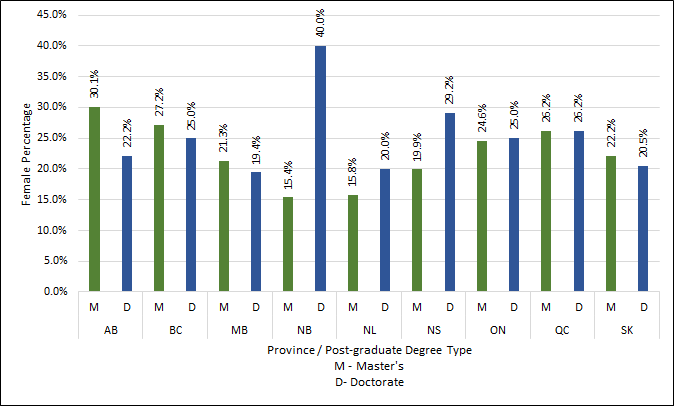
International students
International undergraduate enrolment
There were 13,941 international students enrolled in undergraduate engineering programs in 2018, accounting for 15.6 per cent of total enrolment. When comparing institutions that consecutively replied to this survey since 2014, international students represented 14.9 per cent of total undergraduate enrolment and 16.3 per cent in 2017. This means that the proportion of international students enrolled in undergraduate engineering programs has increased 4.5 per cent since 2014 but has decreased 3.9 per cent over the previous year.
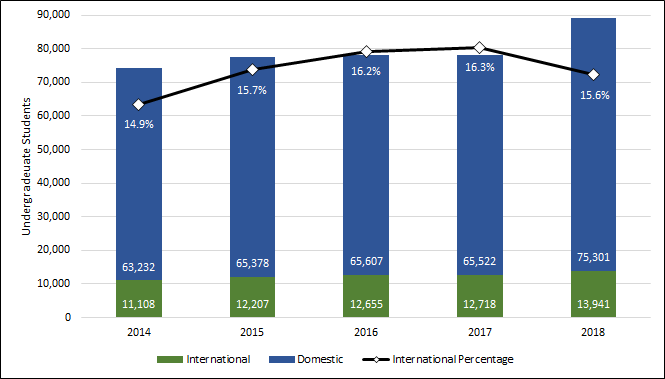
International undergraduate enrolment by discipline
Materials or metallurgical engineering, and mining or mineral engineering had the highest proportion of international students enrolled, at 32.1 per cent and 20.2 per cent, respectively. Conversely, the programs that displayed the lowest proportion of international students were geological engineering and biosystems engineering, 8.9 per cent and 10.8 per cent, respectively.

International undergraduate enrolment by province
Out of the 13,941 international students enrolled in undergraduate engineering programs in Canada in 2018, 40.7 per cent (5,670) studied in Ontario and 24.8 per cent (3,456) studied in Quebec. Nova Scotia and Saskatchewan had the highest proportion of international students enrolled at 33.6 per cent (754 students) and 21.8 per cent (562 students), respectively. The largest growth in international student enrolment over the previous year occurred in Newfoundland and Labrador (61.5 per cent) and Quebec (16.3 per cent).
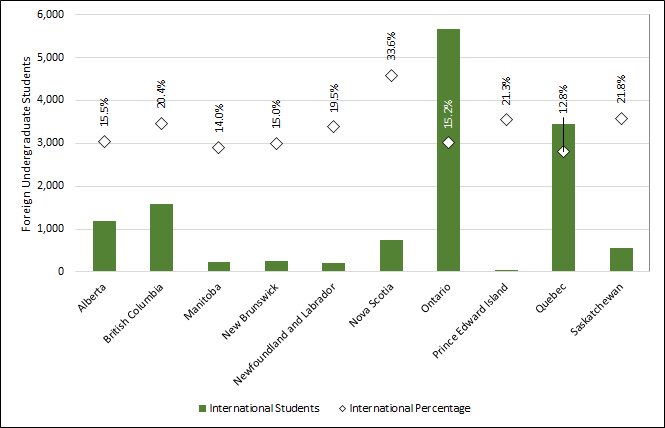
International undergraduate degrees awarded
In 2018, 2,416 of the 16,497 awarded undergraduate degrees were conferred on international students, representing 17.9 per cent overall. When comparing institutions that consecutively replied to this survey since 2014, the proportion of degrees awarded to international students has grown 17.9 percentage points from 2017 and 37.6 percentage points from 2014.
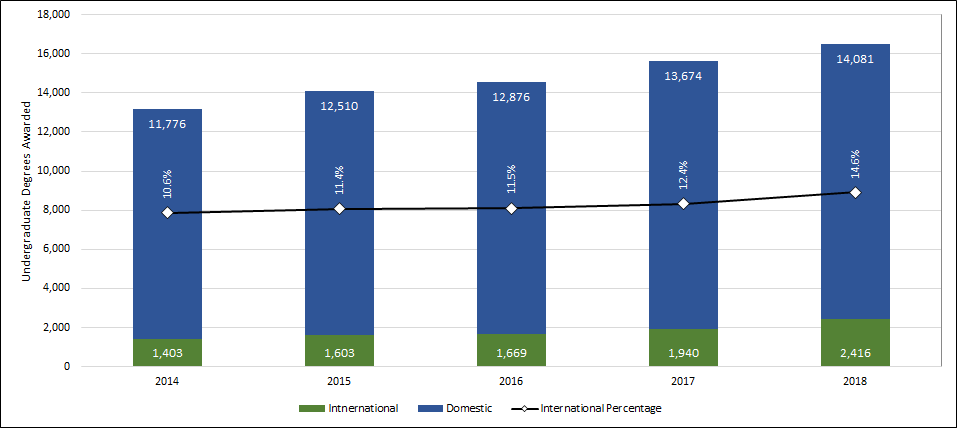
International graduate student enrolment
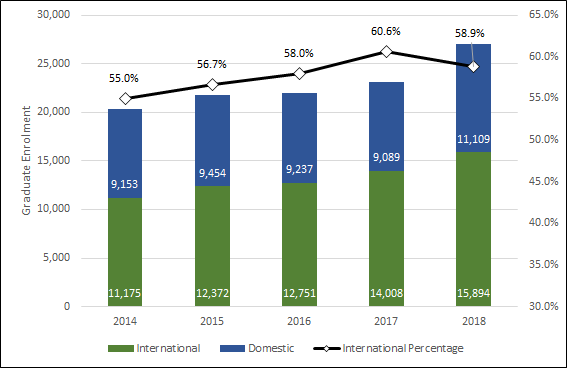
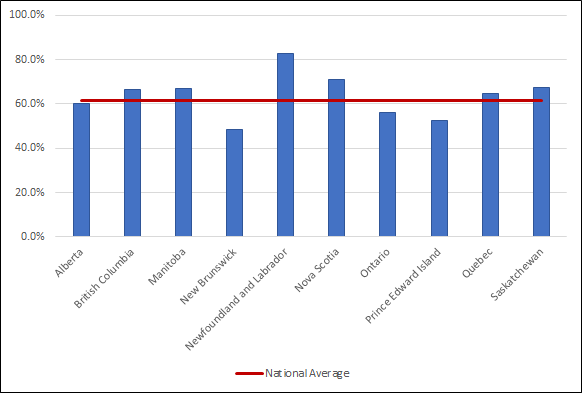
International postgraduate degrees awarded
In 2018, the number of master's degrees awarded to international students totalled 4,976 and the number of doctoral degrees awarded totalled 883. When comparing institutions that consecutively replied to this survey, master’s degrees awarded to international students increased by 9.8 per cent over the previous year and 26.3 per cent from 2014, while doctoral degrees awarded increased by 53.9 per cent over the previous year and 113.9 per cent from 2014.
The proportion of postgraduate degrees awarded to international students reached 64.1 per cent of all master's degrees and 56.0 per cent of all doctoral degrees in 2018. This represents growth from 2014, when the proportion of master's degrees awarded was 50.7 per cent and that of doctoral degrees awarded was 26.2 per cent.
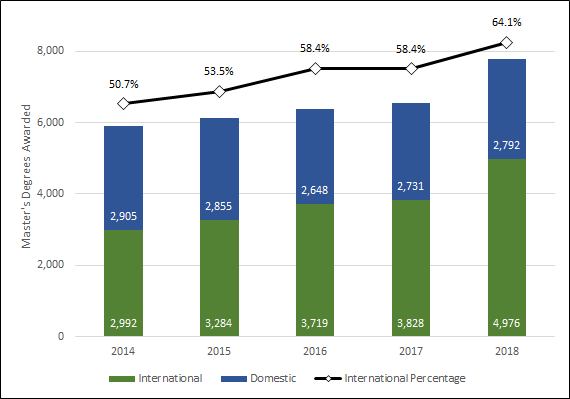
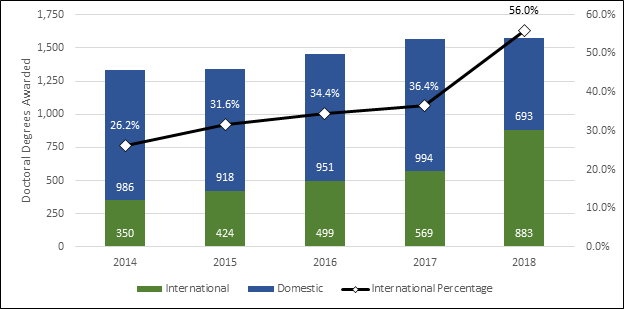
In 2018, Newfoundland and Labrador, Nova Scotia, and Saskatchewan had the greatest proportion of master's degrees awarded to international students at 87.7 per cent, 86.3 per cent, and 75.6 per cent, respectively. Similarly, Newfoundland and Labrador, Quebec, and Saskatchewan awarded the greatest proportion of their doctoral degrees to international students at 80.0 per cent, 65.3 per cent, and 61.5 per cent, respectively.
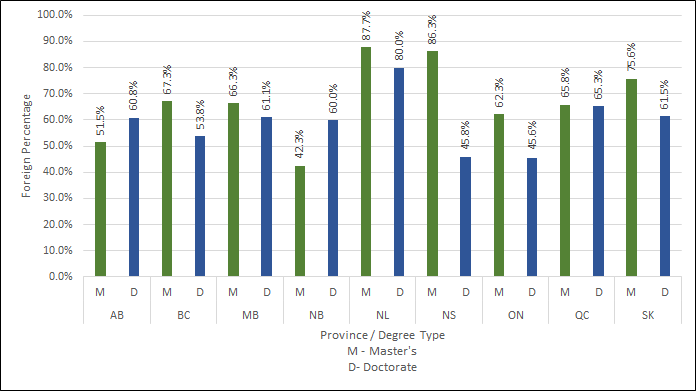
Indigenous peoples’ enrolment and degrees awarded
Of the 45 institutions that responded to the enrolment and degrees awarded survey, 17 provided information about Indigenous students. As the reported numbers are of small magnitude, the data on Indigenous student enrolment is presented in a cumulative form to assure anonymity. While not all institutions are able to report the Indigenous identity of their students, Engineers Canada believes this data allows the engineering community to pursue conversations on increasing the representation of Indigenous peoples in engineering. Even if we cannot currently achieve a comprehensive and true representation of Indigenous peoples' enrolment and degrees awarded, this provides us with an important starting point.
Of the 17 institutions who provided data, 15 institutions provided information on undergraduate enrolment, representing 46.7 per cent of all undergraduate students enrolled in engineering programs in Canada. Nine institutions provided information on undergraduate degrees awarded, representing 25.2 per cent of undergraduate degrees awarded. Furthermore, 10 institutions provided data on Indigenous student enrolment in graduate programs, representing 25.4 per cent of postgraduate students in Canada. Three institutions provided data on postgraduate degrees awarded, representing 12.6 per cent of postgraduate degrees awarded.
While Indigenous peoples make up 4.9 per cent of the population in Canada (Statistics Canada, 2017), Indigenous students only account for 0.5 per cent of total undergraduate enrolment in engineering programs and 0.5 per cent of undergraduate degrees awarded. Postgraduate student enrolment demonstrated lower enrolment of Indigenous people, at 0.2 per cent of total enrolment, while 0.1 per cent of postgraduate degrees were awarded to Indigenous students.
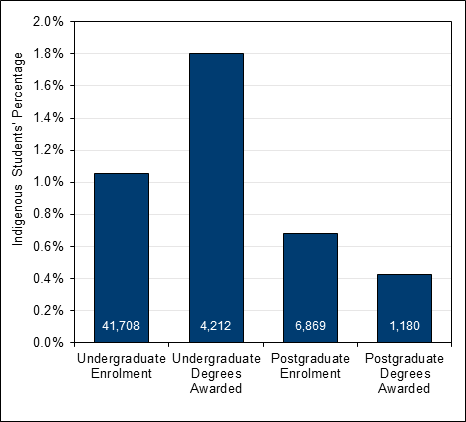
Faculty members
There was a total of 4,696 full-time equivalent engineering faculty members in 2018. When comparing institutions that consecutively replied to this survey since 2014, the number of full-time equivalent faculty members increased by 8.9 per cent from 2017 and 14.2 per cent from 2014.
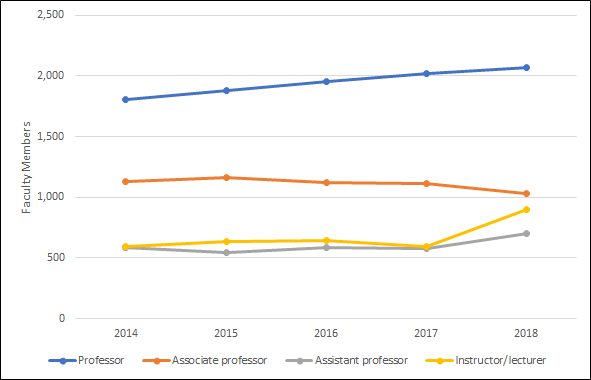
The percentage of female faculty members has increased from 13.4 per cent in 2013 and 14.9 per cent in 2016, to 15.5 per cent in 2017. The faculty position with the highest percentage of females was that of assistant professors (23.0 per cent), whereas the position with the lowest percentage was that of professor (11.2 per cent).
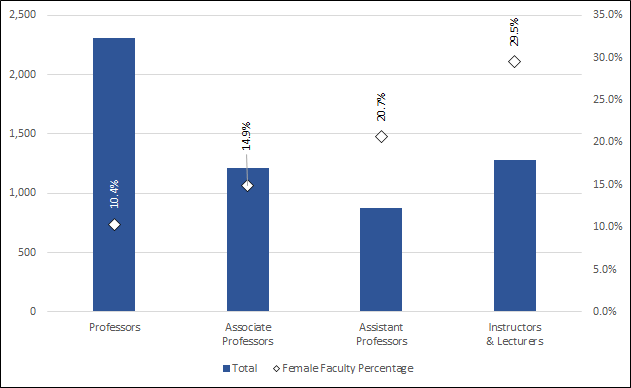
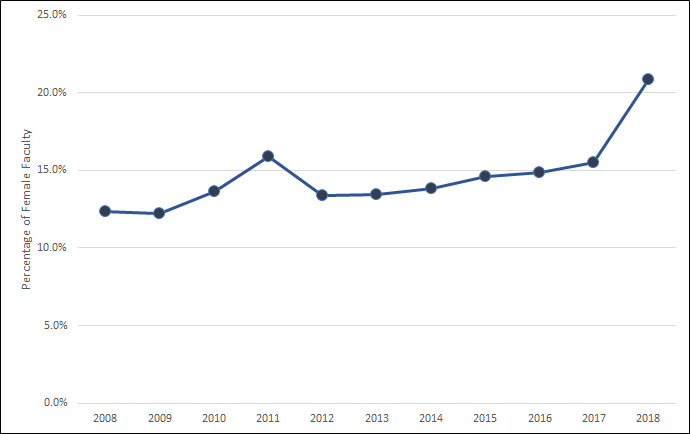
Small inaccuracies in the reported data as well as changes in programming will affect the percentage presented in Chart 5.3.
Appendix A
Data tables can be downloaded in Excel format
Undergraduate Enrolment (U)
Undergraduate Degrees Awarded (UD)
Postgraduate Student Enrolment (G)
Postgraduate Degrees Awarded (GD)
Faculty Members by institution (F)
Co-op, Internship, and Professional Experience Programs (C)
